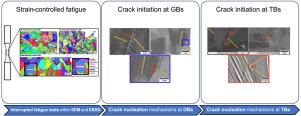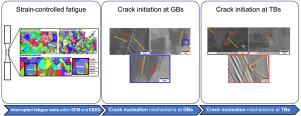Slip transfer and crack initiation at grain and twin boundaries during strain-controlled fatigue of solution-hardened Ni-based alloys
IF 8.3
1区 材料科学
Q1 MATERIALS SCIENCE, MULTIDISCIPLINARY
引用次数: 0
Abstract
Slip transfer/blocking at grain and twin boundaries as well as preferential fatigue crack nucleation locations were studied in two solution-hardened Ni-based alloys (Inconel 600 and Hastelloy C276) deformed under strain-controlled, fully-reversed cyclic deformation in the low-cycle fatigue regime. Electron backscatter diffraction-based slip trace analysis was used to identify the active slip systems after interrupted fatigue tests. It was found that the Luster-Morris parameter was an accurate geometrical criteria to discriminate between slip transfer and blocking at grain and twin boundaries. Moreover, it was found that fatigue cracks initiation was always intergranular and cracks were nucleated at grain and twin boundaries when the slip transfer across was blocked. The probability of crack nucleation increased with the misorientation angle and was independent of the grain size. This behavior was associated with the development of stress concentrations at grain and twin boundaries as well as triple junctions in which slip was blocked and is different from previous reports on fatigue crack nucleation in Ni-based superalloys deformed, in which the slip system parallel to the TB in the parent grain was suitably oriented for slip. This contrast in the fatigue crack nucleation sites between both types of Ni alloys were attributed to the differences in the degree of strain localization and show how this factor controls damage nucleation in polycrystals.


溶液硬化镍基合金应变控制疲劳过程中晶粒和孪晶边界的滑移和裂纹萌生
研究了两种溶液硬化镍基合金(Inconel 600 和 Hastelloy C276)在应变控制、完全反向循环变形的低循环疲劳机制下,晶粒和孪晶边界的滑移转移/阻塞以及疲劳裂纹的优先成核位置。基于电子反向散射衍射的滑移轨迹分析用于识别间断疲劳试验后的活动滑移系统。研究发现,Luster-Morris 参数 m′=0.6m′=0.6 是区分晶粒和孪晶边界滑移转移和阻塞的准确几何标准。此外,研究还发现,当滑移传递受阻时,疲劳裂纹总是在晶间萌生,而裂纹则在晶粒和孪晶边界成核。裂纹成核的概率随取向角的增大而增大,与晶粒大小无关。这种行为与晶粒和孪晶边界处的应力集中以及滑移受阻的三重交界处的应力集中有关,与之前有关镍基超合金变形中疲劳裂纹成核的报告不同,在镍基超合金变形中,平行于母体晶粒中 TB 的滑移系统具有适当的滑移方向。两类镍合金疲劳裂纹成核部位的这种对比归因于应变局部化程度的差异,并说明了这一因素如何控制多晶体中的损伤成核。
本文章由计算机程序翻译,如有差异,请以英文原文为准。
求助全文
约1分钟内获得全文
求助全文
来源期刊

Acta Materialia
工程技术-材料科学:综合
CiteScore
16.10
自引率
8.50%
发文量
801
审稿时长
53 days
期刊介绍:
Acta Materialia serves as a platform for publishing full-length, original papers and commissioned overviews that contribute to a profound understanding of the correlation between the processing, structure, and properties of inorganic materials. The journal seeks papers with high impact potential or those that significantly propel the field forward. The scope includes the atomic and molecular arrangements, chemical and electronic structures, and microstructure of materials, focusing on their mechanical or functional behavior across all length scales, including nanostructures.
 求助内容:
求助内容: 应助结果提醒方式:
应助结果提醒方式:


